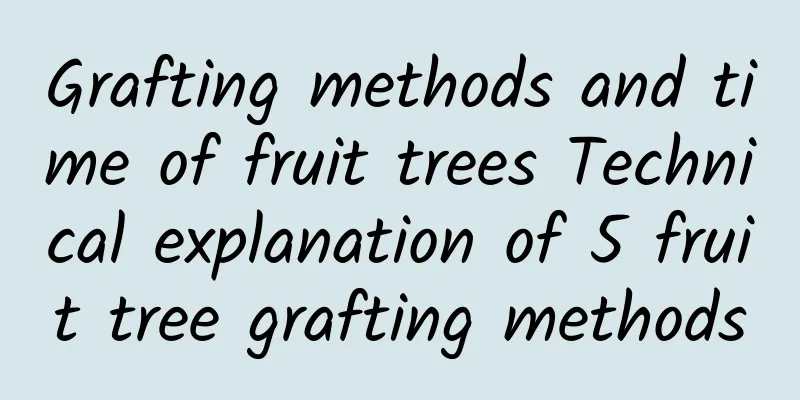Grafting methods and time of fruit trees Technical explanation of 5 fruit tree grafting methods

|
For fruit trees, grafting can not only maintain the excellent traits of the original variety, but also improve the quality and yield of the fruit, shorten the fruiting period of fruit trees, harvest early, improve growth and enhance resistance. There are several methods of grafting fruit trees1. Branch grafting Cut grafting and cleft grafting are two common grafting methods. The former is suitable for thin branches, usually 1-2 cm, in early spring, while the latter is suitable for thick branches. After the two branches are tied together, they are sealed with soil. 2. Docking Two plants with similar branch thickness are tied together. In fact, the two grafting methods are not easy to survive. Approach grafting is a grafting option with a high survival rate. Osmanthus and camellia are all grafted using the approach grafting method. The scion branches and the grafting stock are selected to be of similar thickness. They are cut obliquely into circles with a diameter of about 4 cm, tied together with ribbons, and then smeared and sealed with mud. 3. Bud grafting The new buds are tied to the branches and the budding is completed in more than two months. Select a branch that has not sprouted, cut it and graft it onto the rootstock to complete the grafting. The rootstock is required to be about two years old. One week after bud grafting, you can touch the grafted part of the petiole with your hand. If the leaves fall off, it proves that the grafting is successful. 4. Inlaid branches The inlay branches must meet two conditions: first, the thick branches that are more than 23 years old are used as rootstocks, which are inlay branches. Second, the scion part meets the requirements of lignification. 5. Butt joint Cactus plants are usually grafted flatly. The cut surfaces on both sides of the graft should be smooth and tied with plastic tape to allow them to gradually merge. Best Time to Graft a TreeFruit tree grafting is usually carried out in spring and autumn . If grafting is carried out at this time, the plant interface will heal faster and the chance of survival will be higher. In addition, it is also easy to manage during the later stage of cultivation. Grafting can be done in the summer, but it is not conducive to wound healing. In winter, most trees are dormant, so it is difficult for them to survive if grafted at this time. How to graft fruit trees to achieve a high survival rate1. The grafting time should be appropriate Fruit tree grafting should be carried out before budding, when the quality of the rootstock and scion is better, and the temperature and humidity are suitable for the vigorous separation of the cells of the grafted cambium, which can accelerate the healing of the incision. 2. The selection of rootstock and scion should be scientific You should choose rootstocks and scions that have strong affinity, strong growth, no diseases, full development, and plump new buds. The stronger the affinity, the higher the survival rate. At the same time, the rootstock should be selected to avoid the most vigorous growth period of the rootstock to prevent the growth of the rootstock and scion from being uncoordinated, which will reduce the survival rate after grafting. The specific selection can be based on the type of grafted fruit tree. 3. Find the right time for grafting Before grafting, the garden should be disinfected and cleaned in advance, and the weather conditions for the next few days should be understood in advance. It is best if there is no heavy rain 3-5 days after grafting. The grafting process should be fast. It is best to use the scion branches as soon as they are picked. At the same time, the scion should be prevented from being left for too long, causing dehydration or oxidation, which will reduce the survival rate of the grafting. 4. Choose the grafting method according to the fruit tree variety For those tree species that are easy to survive after grafting, such as peach, pear, apricot, citrus, etc., the "T" shaped bud grafting method can be used. For tree species such as apple and persimmon, square bud grafting or xylem bud grafting can be used. The larger the contact area between the bud and the rootstock, the higher the survival rate. For tree species with low grafting survival rate, such as walnut, double-door grafting or sleeve grafting can be used, which can effectively improve the grafting survival rate. 5. Check after grafting Generally speaking, whether a fruit tree has survived can be determined 7-15 days after grafting. If the petiole turns from green to yellow and falls off when touched, the grafting is successful. If the petiole turns from green to black or becomes dry, it proves that the grafting has failed and a second grafting should be carried out in time. |
Recommend
How to grow osmanthus
1. Watering in time If you want to grow osmanthus...
Growth order of gourd
1. Germination period The period from when the go...
The difference between Michelia intoxica and Michelia sempervirens
What is Michelia intoxicans Michelia sempervivum ...
How to propagate Desert Rose
1. Cutting method When taking cuttings for Desert...
How to plant avocado seeds, avocado pictures
1. Seed processing When planting, take seeds from...
When does the peony sprout and grow leaves?
Peony budding time Peonies generally sprout and g...
Paphiopedilum cultivation methods and precautions
1. Maintenance methods 1. Temperature: Paphiopedi...
How to grow African jasmine so that it blooms
African jasmine flowering time African jasmine ne...
Can Schefflera be exposed to the sun? Does it need to be exposed to the sun often?
Can Schefflera chinensis be exposed to the sun? S...
How many years does it take for the jujube to bear fruit?
Introduction to planting jujube The jujube mainly...
How to care for hibiscus in winter
Is hibiscus afraid of cold? Hibiscus is afraid of...
Pictures of fertilizer damage caused by excessive fertilization of peppers (how to prevent and control fertilizer damage in the seedling stage of pepper planting)
Peppers are widely used in diet. Many growers spr...
Can the fortune tree be exposed to the sun or placed on the windowsill?
1. Can it be exposed to the sun? When the sunligh...
The time and method of topping the leaf fairy
Does the leaf fairy need to be topped? If you wan...
How to make tea with dried gardenia
1. How to dry gardenia If you want to make tea wi...









